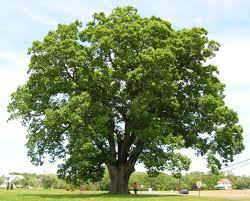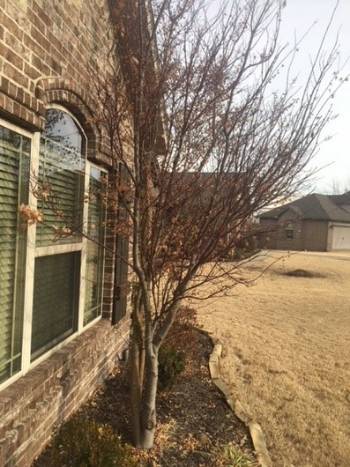Picking the Right Tree for a Place

Growing up, one of my favorite sayings was, “The best time to plant a tree was 20 years ago. The second-best time is today”. Trees can enhance the beauty of your home, increase its value, and make your yard enjoyable by providing shade. However, the wrong tree in the wrong place can damage your property and become an issue rather than an asset. Most of the problems with trees I see could have been prevented with some planning and simple questions.
My question when someone asks what tree they should plant is always, what is the purpose of the tree? What someone wants from their tree will impact my answer and my recommendation of where to plant it. Trees can provide shade, blooms, and color, serve as a windbreak, and a home for wildlife; the uses are endless, but no one can provide all of those items. Having an idea of what you want your tree to do will drastically narrow down the options. I’m considering adding a tree to my front yard to replace the Sweet Gum that is growing there eventually. I want a shade tree that will also have some fall color and does not have large seeds. I do like my Sweet Gum, but the seeds are a pain. I don’t need a tree that will be fast-growing because this is a long-term project, but I don’t necessarily want one that will be extremely slow-growing. Know what you want out of a tree before you buy one.

One of the most critical and often overlooked parts of planting a tree is picking the right place. All too often, I see large trees planted less than 10’ from a house or building, and the homeowner wants to know how to prune it to keep it away from the house or the roots are causing issues with the foundation, and they want to know how to solve the problem. The biggest mistake most homeowners make when planting a tree is failing to allow enough room for growth. A large tree should be at least 20’ away from a house to allow it enough room to grow during its lifetime while still providing shade for the house. Along with planting trees too close to a house, we often plant trees too close together. Trees are free spirits; give them room to grow. If the tag says a tree will get 40 feet across, you should plant the next tree at least 50 feet away. That gives each tree approximately 20’ to grow toward each other and a little bit extra because, let’s be honest, trees don’t read their tags, and many will outgrow what the tag says in their lifetime.
When picking a tree species, my final question is, what is your yard like? Is your soil shallow, and is the yard rocky? Does part of the yard hold water, or does the area drain well? All of those questions factor into the type of tree you pick. If your yard tends to be slow draining, a Blue Spruce is not the right tree for you because it will drown. On the other side of the coin, if your yard is rocky and has sandy soil, a Willow tree will not be happy unless you water it constantly. It’s essential to know the limitations of your yard (moisture, soil type, overhead power lines, utilities, etc) before selecting a tree to reduce your chances of having issues down the road.
As you select a tree, be sure to research some potential issues the tree could have. Silver Maples are fast-growing and great shade trees but are also weaker because they are fast-growing and often lose small branches during wind storms. American Elm trees are semi-fast-growing trees that are sturdy and long-lived, but you have to contend with Dutch Elm disease. Unfortunately, there is no perfect tree out there, but with some research and planning, you can find the tree that will be perfect for you and your yard this growing season.

Have questions? Contact our office where our Horticulture Extension Agent will assist you with questions.
Phone: (316) 321-9660
Email: callae@ksu.edu